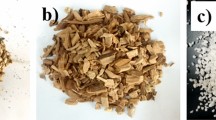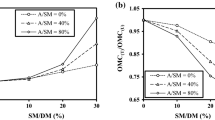Abstract
Although work has been done to understand the sintering behavior and properties of Municipal Waste Incinerator Bottom Ashes to produce sintered (Bethanis et al. in Ceram Int 28:881–886, 2002; Cheeseman et al. in Resour Conserv Recycl 43:147–162, 2005; Bourtsalas et al. in Waste Manag 45:217–225, 2014; Taurino et al. in J Eur. Ceram Soc 37:323–331, 2017) or sinter-crystallized (Schabbach et al. in J Non Cryst Solids 357:10–17, 2011; Barbieri et al. in J Non Cryst Solids 354:521–528, 2008) ceramics, most of the trials reported in the literature focuses on the use of extensively milled bottom ashes powders (particle size around 1–50 µm), using processes that might not be easily transferable to industrial production at reasonable cost, and producing small cylinders with uniaxial compression technique on powders. This paper summarizes the development process of an extruded ceramic material made of gross-milled bottom ashes and waste clay, designed to be easily mass-produced using production capacities available in the building bricks industry, to be used as a high-temperature thermal energy storage material, which represents an alternative to the petrurgic ceramic previously developed for this application (Py et al. in J Sol Energy Eng 133:031008, 2011; Kere et al. in Int Conf Eng Waste Biomass Valoris, Porto, 2012; Py et al. in Stockage de l’ énergie: énergie thermique, stockage thermique haute température). Post-treated incinerator bottom ashes from a commercial incinerator has been collected, characterized and processed to form ceramic materials, using clay as a binder. Ashes were milled, dried, and mixed with various amounts of an illitic clay (produced as washing mud by a quartz quarry) prior to extrusion (cylindrical pellet) and firing at different temperatures, ranging from 1100 to 1120 °C. The sintered samples have been characterized in terms of density, mechanical strength, thermal capacity and thermal conductivity. Their mineral structure has also been studied. This work follows a study on the feasibility about the production of MWIBA based slabs with uniaxial compaction, and can be seen as an improvement regarding the shaping of the green bodies, more compatible with thermocline thermal energy storage process. The resulting sintered ceramics exhibit interesting properties such as relatively high mechanical resistance and low thermal conductivity, along with moderate density. These properties allow envisioning the use as filler material for thermocline thermal storage systems, especially considering the simplicity of the production process, relying on dry gross milling (jaw-mill), and firing at a temperature reachable within the building bricks and tiles industry. Production of adequate pieces to be used as thermal storage media seems however more relevant, the small size limiting the impact of sintering heterogeneities (formation of black bodies due to high content in fluxing agents like sodium and potassium).











Similar content being viewed by others
References
Bethanis, S., Cheeseman, C.R., Sollars, C.J.: Properties and microstructure of sintered incinerator bottom ash. Ceram. Int. 28, 881–886 (2002). https://doi.org/10.1016/S0272-8842(02)00068-8
Cheeseman, C.R., Makinde, A., Bethanis, S.: Properties of lightweight aggregate produced by rapid sintering of incinerator bottom ash. Resour. Conserv. Recycl. 43, 147–162 (2005). https://doi.org/10.1016/j.resconrec.2004.05.004
Bourtsalas, A., Vandeperre, L.J., Grimes, S.M., Themelis, N., Cheeseman, C.R.: Production of pyroxene ceramics from the fine fraction of incinerator bottom ash. Waste Manag. 45, 217–225 (2014). https://doi.org/10.1016/j.wasman.2015.02.016
Taurino, R., Karamanov, A., Rosa, R., Karamanova, E., Barbieri, L., Atanasova-vladimirova, S., et al.: New ceramic materials from MSWI bottom ash obtained by an innovative microwave-assisted sintering process. J. Eur. Ceram. Soc. 37, 323–331 (2017). https://doi.org/10.1016/j.jeurceramsoc.2016.08.011
Schabbach, L.M., Andreola, F., Karamanova, E., Lancellotti, I., Karamanov, A., Barbieri, L.: Integrated approach to establish the sinter-crystallization ability of glasses from secondary raw material. J. Non Cryst. Solids. 357, 10–17 (2011). https://doi.org/10.1016/j.jnoncrysol.2010.10.006
Barbieri, L., Karamanov, A., Corradi, A., Lancellotti, I., Pelino, M., Rincon, J.M.: Structure, chemical durability and crystallization behavior of incinerator-based glassy systems. J. Non Cryst. Solids 354, 521–528 (2008). https://doi.org/10.1016/j.jnoncrysol.2007.07.080
Py, X., Calvet, N., Olives, R., Meffre, A., Echegut, P., Bessada, C., et al.: Recycled material for sensible heat based thermal energy storage to be used in concentrated solar thermal power plants. J. Sol. Energy Eng. 133, 031008 (2011). https://doi.org/10.1115/1.4004267
Kere, A., Dejean, G., Sadiki, N., Olives, R., Goetz, V., Py, X., et al.: Vitrified Industrial wastes as thermal energy storage materials for high temperature applications, in: Int. Conf. Eng. Waste Biomass Valoris, Porto, 2012
Py, X., Olives, R., Goetz, V., Falcoz, Q., Meffre, A., Kere, A., et al.: Stockage de l’ énergie: énergie thermique, stockage thermique haute température, (n.d.)
Crillesen, K., Skaarup, J., Bojsen, K., et al.: International Solid Waste Association: Management of bottom ash from WTE plants—an overview of management options and treatment methods. ISWA, (2006). https://www.iswa.org/uploads/tx_iswaknowledgebase/Bottom_ash_from_WTE_2006_01.pdf
Cavaud, D., Coléou, Z., Guggemos, F., Reynaud, D.: Chiffres clés des énergies renouvelables-Edition 2016, Ministère de l’environnement, 2017. https://www.statistiques.developpement-durable.gouv.fr/chiffres-cles-desenergies-renouvelables-edition-2016
International Solid Waste Association: Waste-to-Energy State-of-the-Art-Report. International Solid Waste Association, Copenhagen (2012)
Vu, D.H., Wang, K.-S., Chen, J.-H., Nam, B.X., Bac, B.H.: Glass–ceramic from mixtures of bottom ash and fly ash. Waste Manag. 32, 2306–2314 (2012). https://doi.org/10.1016/j.wasman.2012.05.040
Aloisi, M., Karamanov, A., Taglieri, G., Ferrante, F., Pelino, M.: Sintered glass ceramic composites from vitrified municipal solid waste bottom ashes. J. Hazard. Mater. 137, 138–143 (2006). https://doi.org/10.1016/j.jhazmat.2005.12.056
Appendino, P., Ferraris, M., Matekovits, I., Salvo, M.: Production of glass–ceramic bodies from the bottom ashes of municipal solid waste incinerators. J. Eur. Ceram. Soc. 24, 803–810 (2004). https://doi.org/10.1016/S0955-2219(03)00264-4
Barbieri, L., Corradi, A., Lancellotti, I.: Bulk and sintered glass-ceramics by recycling municipal incinerator bottom ash. J. Eur. Ceram. Soc. 20, 1637–1643 (2000). https://doi.org/10.1016/S0955-2219(00)00032-7
Acceptabilité environnementale de matériaux alternatifs en technique routière—Les mâchefers d’incinération de déchets non dangereux (MIDND), Sétra, Ministère de l’Ecologie, 2006. http://www.valenseine.com/wp-content/uploads/2018/03/Guide-SETRA-officiel-Oct-2012.pdf
Rambaldi, E., Esposito, L., Andreola, F., Barbieri, L., Lancellotti, I., Vassura, I.: The recycling of MSWI bottom ash in silicate based ceramic. Ceram. Int. 36, 2469–2476 (2010). https://doi.org/10.1016/j.ceramint.2010.08.005
Lopez Ferber, N., Falcoz, Q., Minh, D.P., Hoffmann, J.F., Meffre, A., Nzihou, A., et al.: Flexibility and robustness of a high-temperature air/ceramic thermocline heat storage pilot. J. Energy Storage 21, 393–404 (2019). https://doi.org/10.1016/j.est.2018.11.034
Dejean, G.: Valorisation de laitiers sidérurgiques comme matériaux de stockage thermique pour procédés énergétiques durables. Application au CSP et au CAES, UPVD, 2014
Kere, A., Sadiki, N., Py, X., Goetz, V.: Applicability of thermal energy storage recycled ceramics to high temperature and compressed air operating conditions. Energy Convers. Manag. 88, 113–119 (2014). https://doi.org/10.1016/j.enconman.2014.08.008
European Commission, Document de référence sur les meilleures techniques disponibles—Fabrication des céramiques (2007)
Taurino, R., Karamanova, E., Barbieri, L., Atanasova-vladimirova, S., Andreola, F., Karamanov, A.: New fired bricks based on municipal solid waste incinerator bottom ash. Waste Manag. Res. 35, 1055–1063 (2017). https://doi.org/10.1177/0734242X17721343
Zavattoni, S.A.A., Barbato, M.C.C., Pedretti, A., Zanganeh, G., Steinfeld, A.: High temperature rock-bed TES system suitable for industrial-scale CSP Plant—CFD analysis under charge/discharge cyclic conditions. Energy Procedia 46, 124–133 (2014). https://doi.org/10.1016/j.egypro.2014.01.165
IUPAC, Compendium of Chemical Terminology—Gold Book. IUPAC, Research Triangle Park (2014)
Becquart, F., Bernard, F., Abriak, N.E., Zentar, R.: Monotonic aspects of the mechanical behaviour of bottom ash from municipal solid waste incineration and its potential use for road construction. Waste Manag. 29, 1320–1329 (2009). https://doi.org/10.1016/j.wasman.2008.08.019
Rahaman, M.N.: Ceramic Processing, 2nd edn. CRC Press, Boca Raton (2017)
Cheeseman, C.R., Monteiro Da Rocha, S., Sollars, C., Bethanis, S., Boccaccini, A.R.: Ceramic processing of incinerator bottom ash. Waste Manag. 23, 907–916 (2003). https://doi.org/10.1016/S0956-053X(03)00039-4
Schabbach, L.M., Andreola, F., Barbieri, L., Lancellotti, I., Karamanova, E., Ranguelov, B., et al.: Post-treated incinerator bottom ash as alternative raw material for ceramic manufacturing. J. Eur. Ceram. Soc. 32, 2843–2852 (2012). https://doi.org/10.1016/j.jeurceramsoc.2012.01.020
Techniques de l’ingénieur, Frittage: aspects physico-chimiques Partie 1: frittage en phase solide, 2005. http://www.techniques-ingenieur.fr/base-documentaire/sciences-fondamentales-th8/fondamentaux-en-chimie-42106210/frittage-aspects-physico-chimiques-af6620/
Kato, T., Ohashi, K., Fuji, M., Takahashi, M.: Water absorption and retention of porous ceramics fabricated by waste resources, J. Ceram. Soc. Jpn. 116(1350), 212–215 (2008)
Vichaphund, S., Thavorniti, P.: Properties of ceramic produced from clay and MSW incineration bottom ash mixtures. Sci. Technol. Asia 15, 89–93 (2010)
Anovitz, L.M., Blencoe, J.G.: Dry melting of high albite. Am. Mineral. 84, 1830–1842 (1999). https://doi.org/10.2138/am-1999-11-1210
Auerkari, P.: Mechanical and physical properties of engineering alumina ceramics. Tech. Res. Cent. Finl. 1792, 26 (1996)
Funk, J.E., Dinger, D.R.: Predictive Process Control of Crowded Particulate Suspensions—Applied to Ceramic Manufacturing. Springer, New York (1994)
Fennis, S.A.A.M., Walraven, J.C.: Using particle packing technology for sustainable concrete mixture design. Heron 57, 73–102 (2012)
Shi, C., Wu, Z., Lv, K., Wu, L.: A review on mixture design methods for self-compacting concrete. Constr. Build. Mater. 84, 387–398 (2015). https://doi.org/10.1016/j.conbuildmat.2015.03.079
Zheng, J., Johnson, P.F., Reed, J.S.: Improved equation of the continuous particle size distribution for dense packing, J. Am. Ceram. Soc. 73(5), 1392–1398 (1990)
Kalpakli, Y.K.: Effects of particle size distribution on the refractory properties and corrosion mechanism of ultra-low cement castables. Arch. Mater. Sci. Eng. 34, 81–88 (2008)
Acknowledgements
This work was supported by the Programme “Investissements d’avenir” (Investment for the Future) of the Agence Nationale de la Recherche (National Agency for Research) of the French State under Award Number ANR-10-LABX-22-01-SOLSTICE. The author would also like to thank Eco-Tech Ceram for their scientific, material and financial support and the laboratory SPCTS CNRS UMR 7315 for their support.
Author information
Authors and Affiliations
Corresponding author
Additional information
Publisher’s Note
Springer Nature remains neutral with regard to jurisdictional claims in published maps and institutional affiliations.
Rights and permissions
About this article
Cite this article
Lopez Ferber, N., Pham Minh, D., Falcoz, Q. et al. Ceramics from Municipal Waste Incinerator Bottom Ash and Wasted Clay for Sensible Heat Storage at High Temperature. Waste Biomass Valor 11, 3107–3120 (2020). https://doi.org/10.1007/s12649-019-00617-w
Received:
Accepted:
Published:
Issue Date:
DOI: https://doi.org/10.1007/s12649-019-00617-w




